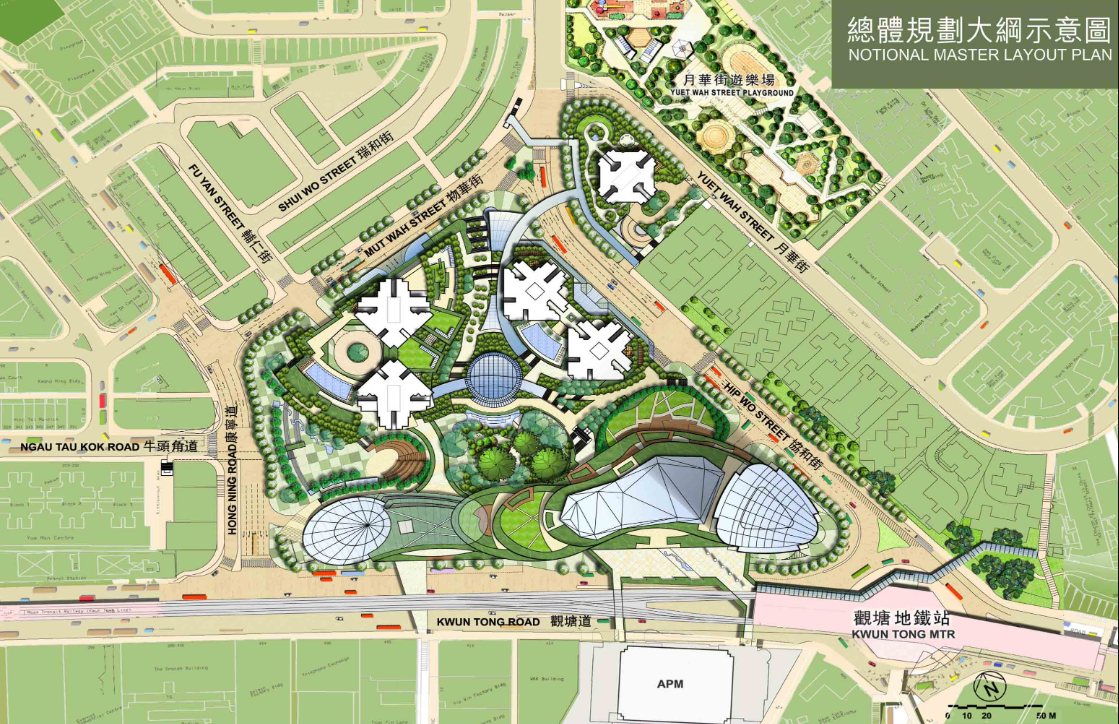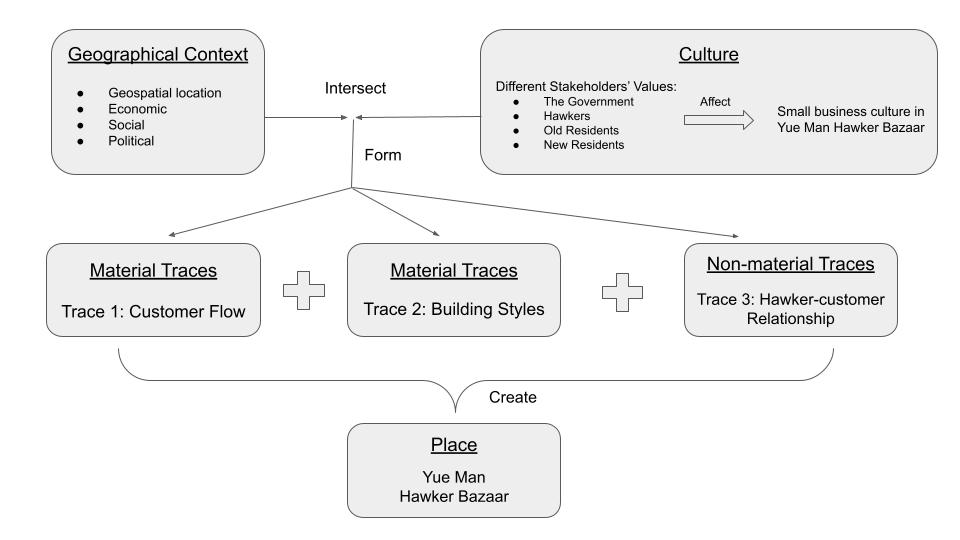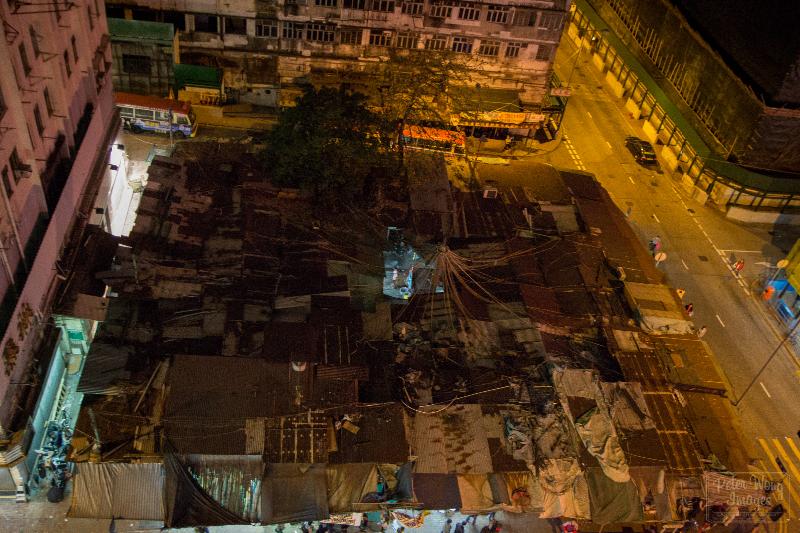1. Introduction
Being the largest reconstruction project in Hong Kong, Kwun Tong Town Centre Redevelopment Project induces big changes in the scenery, facilities and cultures in the district. Yue Man Hawker Bazaar (Figure 1), where many small businesses were found, was affected as well. Originally located on Mut Wah Street and Hip Wo Street, the bazaar had to be temporarily moved to Tung Yan Street in 2014 and ultimately situated at the base level of Yue Man Square from 2021 onwards as the earliest location was a part of the redevelopment project (Figure 2). By stating the research question of our project: “Does Kwun Tong Town Centre Redevelopment Project destroy the original small business culture in Yue Man Hawker Bazaar?”, we hope to find out the special traces that exist in Yue Man Bazaar and the impact of the redevelopment project on the small business culture.

Figure 1. Yue Man Hawker Bazaar
(Source: Fun in Kwun Tong, 2022)

Figure 2. Kwun Tong Town Centre Redevelopment Project
Notional Master Layout Plan
(Source: Urban Renewal Authority, 2007)
2. A Cultural Geographical Perspective on Yue Man Hawker Bazaar
Theoretically, cultural geographical perspectives include geographical context, culture, traces and place. Geographical context does not simply indicate the geospatial location, but also consists of economic, social and political. Culture is the values and thoughts people have. When geographical context and culture intersect with each other, traces, meaning the marks, residues, or remnants, will be formed (Anderson, 2021). They can be divided into two categories, “material” such as architects and “non-material'' such as belongings and memories. The combination of these traces helps create a place, which is Yue Man Hawker Bazaar in this project.
Our project will be separated into two parts. The first section explores the formation and change of three traces, customer flow, building styles and hawker-customer relationship in Yue Man Hawker Bazaar through analyzing the intersection between geographical context and culture, while the second part examines whether the small business culture can be preserved after the redevelopment project via emphasizing on how the values of different stakeholders affect the small business culture in Yue Man Hawker Bazaar from the culture perspective (Figure 3).

Figure 3. Analytical framework of this project
using cultural geography perspectives
(Idea from: Anderson, 2021)
3. Empirical Analysis
3.1 Traces Transformation of Yue Man Hawker Bazaar
3.1.1 Trace 1: Customer Flow
In the 1970s, Kwun Tong hawkers accumulated around the town center, Yue Man Square. Due to problems generated in hygiene and transportation, the government banished the hawkers to the Mut Wah Street basketball court, which was located close to the public housing estates (Can hawker bazaar, 2020). Meanwhile, the rapid development of industry, like manufacturing, in Hong Kong plus the presence of the Kwun Tong Industrial Area provided numerous job opportunities, attracting many people going to the Mut Wah Street Temporary Hawker Bazaar (Au, Lo & Wu, 2014).
In the late 1980s and early 1990s, most of the Hong Kong manufacturers migrated to the mainland due to lower land rent and more labor resources being supplied, causing Hong Kong to experience economic transformation (Au et al., 2014). The beneficial effect in customer flow induced by Kwun Tong Industrial Area no longer existed. Until the implementation of the redevelopment project, Mut Wah Street hawkers shifted to Tung Yan Street, which was located close to the middle-class residence. However, most customers of the bazaar were grassroots so the target customer flow reduced a lot (Can hawker bazaar, 2020). Sharing a similar problem as Tung Yan Street Interim Hawker Bazaar, the position of Yue Man Hawker Bazaar is near the middle-class population. Hence, the target customer flow drops a lot and cannot reach as much as on Mut Wah Street.
3.1.2 Trace 2: Building Styles
Before the redevelopment project, the stores in Mut Wah Street Temporary Hawker Bazaar were packed closely and constructed using iron sheets and canvas (Figure 4). It was not hard to imagine that the environment of the bazaar would be very hot during summer and the ventilation was poor.

Figure 4. Mut Wah Street Temporary Hawker Bazaar
(Source: Hong Kong In-media, 2014)
Later on Tung Yan Street, the external wall of the building was made up of metal laths, anticipating to achieve natural ventilation and maximum day-light utilization to save energy (Yue Man Hawker Bazaar, 2022). Although the ventilation condition had improved, the feeling of hot and stuffy still remained.
With better planning by the government, moving the bazaar from outdoor to indoor, from the ground floor to the base level helped increase the ventilation condition. It becomes a tidy place with air conditioners and the space between the stores widens, creating a more comfortable environment for hawkers and customers.
3.1.3 Trace 3: Hawker-Customer Relationship
In Mut Wah Street Temporary Hawker Bazaar, the hawkers aimed at serving the grassroots as most of the Kwun Tong residents were low-income (Au et al., 2014). Making enormous profits was not their first consideration so the daily necessities they sold were extremely cheap. They focused on the connection with the customers, fostering a sense of belonging.
For instance, a hawker in Yue Man Hawker Bazaar called “Uncle Biu" (標叔), who had been selling school uniforms in Mut Wah Street and Tung Yan Street, experienced a great deficit for decades but he still works 11 hours per day (Tsang, 2020). He believed that if his store, which is next to the exit, is closed, no one will visit the bazaar. Also, some customers who moved out from Kwun Tong come back and purchase school uniforms from him. This hawker-customer relationship is the reason why he keeps working.
Unfortunately, because of a dramatic decline in customer flow in Tung Yan Street and Yue Man Hawker Bazaar, we are afraid that the story of Uncle Biu is just a minority. As an overview at present, the non-profit-based hawker-customer relationship gradually disappeared, as well as the sense of belonging.
3.2 Impact of Different Stakeholders’ Values on the Small Business Culture
3.2.1 The Government
Putting profit and commercializing Kwun Tong as the first priority, the government places the bazaar under Yue Man Square, which has a lot of luxury shops and major chain stores. Although a tidy place is provided, other high-class stores and residents surrounding the bazaar are not compatible with the small business culture. It seems that the government only offers a place to settle down the hawkers but ignores the competitiveness of the bazaar with other markets and shopping centers. Moreover, they neglect the target customer flow of the small business, which is the grassroots, leading to a decline in small business culture.
3.2.2 Hawkers
The hawkers hope to operate on Mut Wah Street after redevelopment while the rebuilding of Yue Man Hawker Bazaar fulfills their desire. Nonetheless, since the new Yue Man Hawker Bazaar is located at the base level, some hawkers worry that it is like a dungeon and will not attract customers, thus inhibiting small business culture preservation.
3.2.3 Old Residents
Most of the old residents in the Yue Man Square area who study or work nearby belong to the grassroots. Their consumption power is low. Statistics from the Census and Statistics Department (2021) show that the average monthly household income in Kwun Tong District was $29,400 in 2021, and 21.5% of the population is over the age of 65. Under the influence of the redevelopment project, the product price in the redeveloped area increases. It is less likely that the low-income old residents can afford the product price so they will probably be squeezed out of the redevelopment zone, even outside the community. A decrease in target customer flow hinders the small business culture.
3.2.4 New Residents
Residents living in Grand Central, which is the closest residence next to Yue Man Hawker Bazaar, are mostly middle class. They can afford HK$20000 rent per month so they are not the target customers of the bazaar. Also, the middle class prefers shopping at night because they need to work during the day. Yet, the bazaar closes at 10 pm every day while other shopping centers nearby like APM close at 2 am (Hon, 2007). These shopping centers are more attractive than the bazaar and they are not likely to go to the bazaar, impeding the preservation of the small business culture.
4. Conclusion
This project explores Yue Man Hawker Bazaar through studying its unique traces formed by the intersection of geographical contexts and culture, and its small business culture before and after the redevelopment project in Kwun Tong with different stakeholders’ values. The aims and expectations of the stakeholders to the redeveloped area are different, as their values and habits differ, and as a result, it can be seen that the location is not fit, causing the target customer flow to decline. This redevelopment project destroys the original small business culture. Whether or not the bazaar can continue, more thinking and considerations will be required.
References
Anderson, J. (2021). Understanding Cultural Geography: Places and Traces. London: Routledge. doi: https://doi.org/10.4324/9780367814816
Au, C. K., Lo, W. S. & Wu, K. C. (2014). Oral History Research Project of Kwun Tong. Retrieved from https://www.kwuntong.org.hk/publications/Oral_History_Research_Project_of_Kwun_Tong.pdf
Census and Statistics Department (2021). Population and Household Statistics Analysed by District Council District. Retrieved from https://www.censtatd.gov.hk/en/data/stat_report/product/B1130301/att/B11303012020AN20B0100.pdf
Hon L. C. (2007). 重建的市區──被規劃的城市生活記憶. [Redeveloped urban areas - planned memory of urban life]. 文化研究@嶺南(4). [Cultural Studies @ Lingnan (4)]. Retrieved from https://www.ln.edu.hk/mcsln/archive/4th_issue/pdf/feature003.pdf
Tsang, F. T. (2020). 裕民市集人流欠奉 檔主為保情誼日開11小時蝕住做 (2020). [Few customers visiting Yue Man Hawker Bazaar Hawkers work 11 Hours per day because of customer relationship] HK01. Retrieved from https://www.hk01.com/article/617003?utm_source=01articlecopy&utm_medium=referral
Yue Man Hawker Bazaar (2022). Fun in Kwun Tong. Retrieved from https://www.kwuntong.org.hk/en/c2_7.html
墟市能存活於市區重建下嗎?(2020). [Can hawker bazaar survive under urban redevelopment?] HK01. Retrieved from https://www.hk01.com/article/510007?utm_source=01articlecopy&utm_medium=referral


